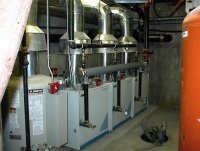1) Fire tube vs Water tube? Any notable advantages of one over the other?
2) If my boiler had 79k BTU output instead of the ~49k(estimated I need), is it fine to run a boiler at low fire using its turndown 24/7?
3) If my boiler BTU output is 49-79k BTUs and I am running at 120 degrees will an indirect hot water tank still work efficiently? It seems most 40-50gal tanks want 90-100k BTUs and only show ratings when the boiler is run @ 180 degrees
4) The only way to get mid 90s efficiency is to have the return water of the boiler ~100 degrees right?
5) Below is a list of boiler manufactures that I have researched. What do you guys suggest and is there someone I should add/remove to/from my list?
Brand(model) - Parts warranty - Heat exchange warranty - Prices
Thank you!
2) If my boiler had 79k BTU output instead of the ~49k(estimated I need), is it fine to run a boiler at low fire using its turndown 24/7?
3) If my boiler BTU output is 49-79k BTUs and I am running at 120 degrees will an indirect hot water tank still work efficiently? It seems most 40-50gal tanks want 90-100k BTUs and only show ratings when the boiler is run @ 180 degrees
4) The only way to get mid 90s efficiency is to have the return water of the boiler ~100 degrees right?
5) Below is a list of boiler manufactures that I have researched. What do you guys suggest and is there someone I should add/remove to/from my list?
Brand(model) - Parts warranty - Heat exchange warranty - Prices
- IBC(SL series) - 5yrs -10yrs then prorated lifetime - ~$3.2k (so far my top pick)
- Lochinvar(Knight) - 5yrs - 10yrs the prorated till 15yrs - $3.4-3.8k (2nd pick)
- Navien(NHB) - 5yrs - 15yrs - ~2k(NHB) - (would be one of my top picks but is completely unavailable in my area)
- Rinnai(I-series) - 5yrs - 12yrs - $2.5-2.7k
- Bosch(greenstar) - 5yrs - 10yrs then prorated lifetime - $2.2k-2.4k
- Lennox(GWM) - 10yrs - 15yrs - ~6-7k(double anything else, WTF??) (surprisingly the best warranty)
- Weil-Mclain(evergreen) - 5yrs - 12yrs - $2.8-3.6k(evergreen)
- HTP(UFT/Elite Ultra/FT) - 5yrs - 10/12yrs - no prices yet
- Utica(SSC/SSV) - 2yrs - 10yrs then prorated till 15yrs - no prices yet
- Slantfin(CHS) - 5yrs, 10yrs then prorated till 15yrs - no prices yet
- Viessmann(Vitodens) - 5yrs -10yrs then prorated lifetime - $3.7k (Most likely not in my area)
- Triangle Tube(Prestige) - 2-6yrs - 10yrs - ~$3.1k
Thank you!
Last edited:


